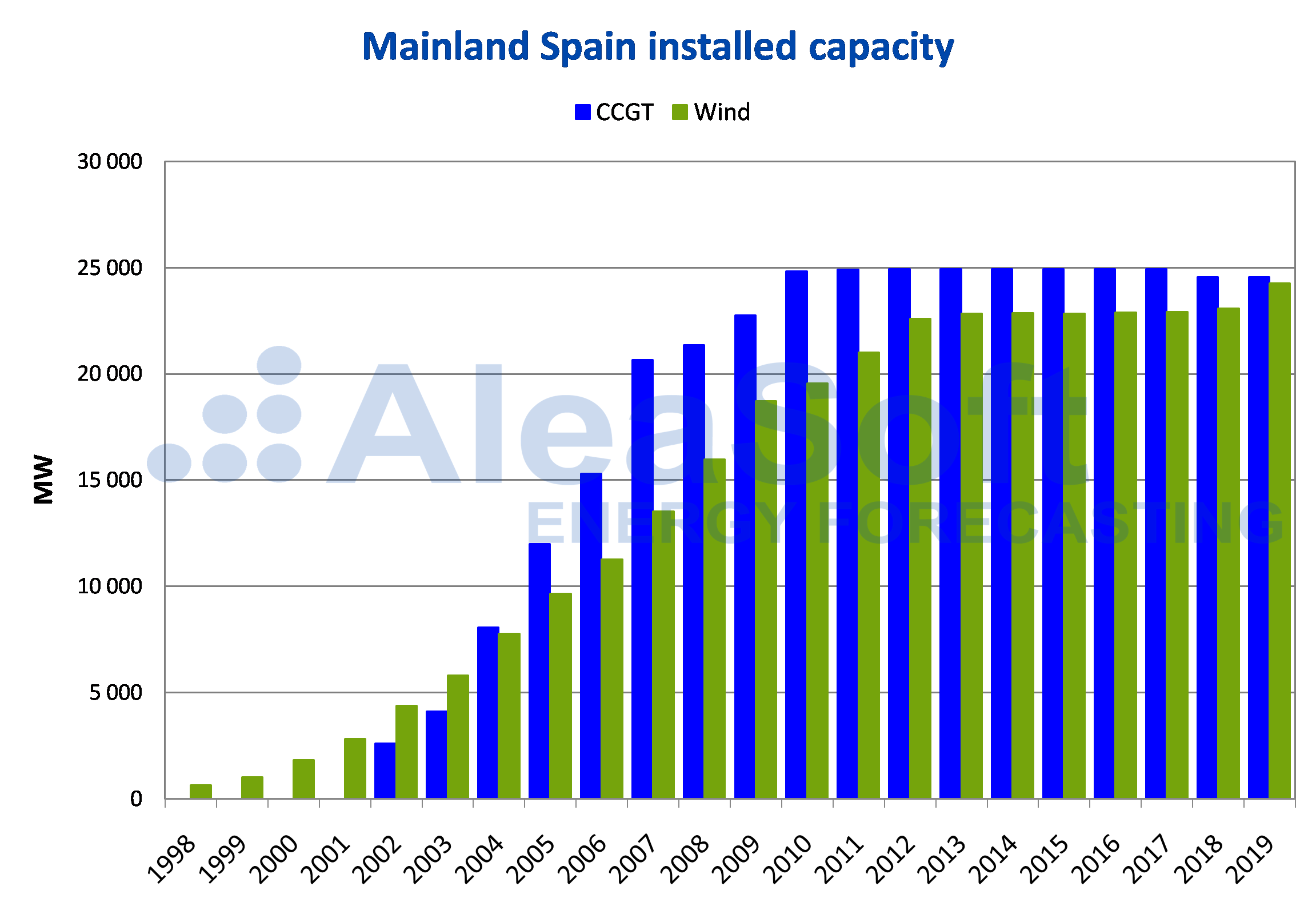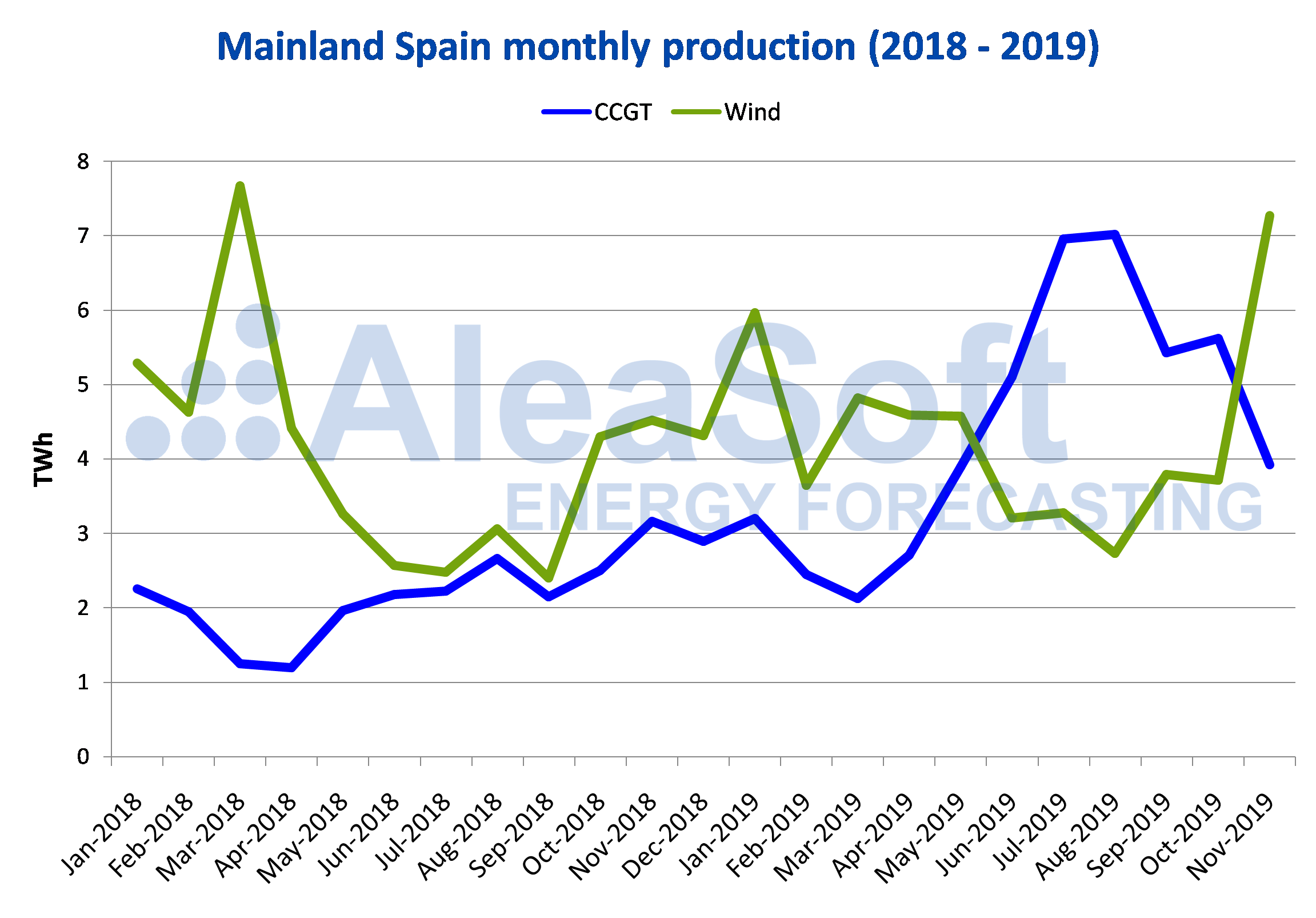AleaSoft, December 10, 2019. The combined cycle gas turbines and the wind energy are currently the technologies with the highest installed capacity in Mainland Spain. Although there was already a wind energy presence when the electricity market began in 1998 and the arrival of the combined cycle gas turbines did not occur until 2002, both have a parallel history that AleaSoft reviews in this article. In the future, the combined cycle gas turbines will be a backup technology in an electricity system where the renewable energy, including the wind energy, will grow considerably.
Installed capacity of combined cycle gas turbines and wind energy
Since the entry into operation of the Spanish electricity market in 1998, there was already an installed wind capacity on the peninsula of 375 MW, according to REE data. This capacity has been increasing over the years, often driven by government grants to encourage the energy transition to renewable energy generation sources. In 2000 the peninsular wind energy capacity grew by 79%, the highest percentage variation since the electricity market began until today. The year 2009 began with an installed capacity of 15 993 MW and that same year another 2722 MW were installed, the largest record of new capacity to date, ending the year with 18 714 MW. As of 2013, in which only 244 MW were installed from the 22 609 MW of 2012, there was a slowdown in the growth of this technology’s capacity. However, the growth rate regained momentum and since then until October 2019, 1168 MW were installed, the current capacity being 24 259 MW.
On the other hand, the combined cycle gas turbine plants began operating in Spain from 2002, with the opening in April of the first combined cycle gas turbine plant of San Roque in Cádiz, with a capacity of 850 MW. That same year another 1796 MW were installed, ending the year with 2619 MW of installed capacity in the peninsula. This technology has been gaining great importance in the energy mix since its entry into operation until today. At the end of 2003, the installed capacity had already grown by 57%, ending the year with 4123 MW and in 2004 it grew almost double, to 8062 MW. The year when more capacity was installed of this technology was 2007, which ended with 5367 MW of new capacity and a total capacity of 20 672 MW. As of 2008, the pace of growth in the installation of new capacity was reduced, coinciding with the reduction of incentives for availability and investments, which became based on auctions and in case of deficit in the demand coverage. From 2008 to 2012, during the period of the economic crisis, only a total of 4276 MW were installed in the peninsula, well below those installed in 2007. Since the end of 2012 until today the installed capacity of the combined cycle gas turbines has not grown up. On the other hand, in 2018, after the closure of the combined cycle gas turbine plant of Tarragona, the installed capacity was reduced by 386 MW, to the current 24 562 MW installed in the peninsula.

Source: Prepared by AleaSoft using data from REE. For the year 2019 data until October 2019.
The installed capacity of the combined cycle gas turbine plants, since 2007, has been around 25% of the total installed capacity of the peninsula, while the wind energy capacity has been gradually increasing, from 16% of that year to 24% of October 2019. Since 2012, both technologies represent about 48% of the installed capacity used to generate electricity in the Spanish peninsular territory.

Source: Prepared by AleaSoft using data from REE.
Combined cycle gas turbine and wind energy production
Since its entry into operation, the combined cycle gas turbines played an important role in the Spanish energy mix. In 2005, four years after entering the mix, the electricity production with this technology covered almost 20% of the electricity demand of the peninsula and reached 34% in 2008. Between 2003 and 2008 the combined cycle gas turbine energy production trend was on the rise, generating much more energy than the wind in those years. But in 2009 the growing trend changed, although it continued to be greater than the wind energy production until 2012. From that year until 2018, the wind energy continued to increase its annual energy production, while that of the combined cycle gas turbines was decreasing. On the other hand, the wind energy production covered 10% of the demand in 2007 and this percentage was gradually increasing to cover about 20% of annual electricity demand in 2018. In 2013, the wind energy generation reached meet 22% of the peninsular demand, the highest percentage of participation of this technology to date.

Source: Prepared by AleaSoft using data from REE.
Throughout the year 2018 and until April 2019, the combined cycle gas turbine electricity production in Mainland Spain was well below its capacity due to the high natural gas and CO2 emission rights prices. As of October of last year, the gas prices began to decline to reach historical lows of the last ten years in June of this year. This decrease in gas prices allowed greater combined cycle gas turbine energy production since May 2019, also coinciding with a decrease in wind energy production. This year the combined cycle gas turbines largely displaced coal, which being more polluting is more affected by the increase in CO2 prices. In addition, the Royal Decree‑Law 15/2018 of October 5 included an exemption from the Special Hydrocarbons Tax for electricity production, better known as green tax, for combined cycle gas turbines, something that also helps them to be more competitive than coal.

Source: Prepared by AleaSoft using data from REE.
In 2018, the peninsular wind energy production of Spain was 85% above the combined cycle gas turbine energy generation. On the contrary, this year, until November 2019, the combined cycle gas turbine plants produced 2% more energy than wind energy farms.
Future perspectives of the combined cycle gas turbines and the wind energy
According to the scenarios proposed in the Integrated National Energy and Climate Plan (NECP), in 2030 the installed capacity in Spain, including the extrapeninsular systems, will be 157 GW, with less participation percentage of technologies that emit CO2, such as combined cycle gas turbines, and an increase in renewable energy technologies, where the wind energy is included. Specifically, the objectives of the NECP are that by 2030 the installed capacity of the combined cycle gas turbines will be 27 GW, very similar to the current one. This technology will play a very important role as backup technology in the energy transition process, taking into account the intermittency of the renewable energies and the planned closure of the nuclear power plants. On the other hand, the objective of the NECP in the case of the wind energy is doubling the current capacity and reaching 50 GW of installed capacity.

Source: Prepared by AleaSoft using data from REE and NECP.
Source: AleaSoft Energy Forecasting.
